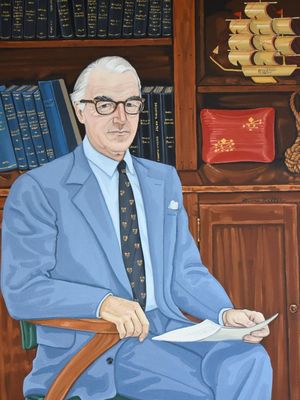Professor Britton Chance
The late Britton Chance was known for his boundless energy and broad range of interests, including his life-long dedication to biophysics, biochemistry and sailing.

Biochemistry and Biophysics
Diane Keller, 1983
Richards Medical Research Laboratories
Dr. Chance's research interests cover a manifold of biochemical, biophysical and medical topics beginning with the discovery of the enzyme substrate compounds of peroxidase and the mechanical differential analyzer solutions of the Michaelis-Menten equations. He branched out into a wide range of studies of enzyme substrate compounds of catalases and peroxidases and, with an ingenious optical method, the discovery of the NADH and flavin components of the respiratory chain together with the observation of multi-site respiratory control and quantum mechanical electron tunneling in the photosynthetic reaction center. The studies were carried out not only in vitro but in vivo (e.g. online human brain redox monitoring in the operating room) and formed the basis for the development of sensitive spectrophotometric methods at room and low temperatures for studying biological systems. The Chance dual wavelength spectrophotometer is still in widespread use. Early studies of NMR progressed from hedgehog brain to human leg (the first human subject NMR studies, using a 1.5T magnet) and thereafter to such applications as diagnosis and treatment of mitochondrial disease and 31P NMR of human neonate neuroblastoma in situ using PME as an indicator of tumor growth or regression. These studies led to the development of near infrared (NIR) spectroscopy and imaging for real time metabolic studies of brain (hematoma detection, prefrontal cortex monitoring, fetal brain oxygenation in utero), breast (cancer detection using signals of angiogenesis and hypermetabolism), skeletal muscle (metabolic monitoring) and cardiac muscle (trans-thoracic detection of hypoxia of myocardium). Many of these studies are ongoing, particularly PFC monitoring during cognition, stress, and deception; and early detection of breast cancer using simple, economical, portable and handheld devices. New fields of research include development and use of high resolution 2- and 3D cryoimaging using molecular beacons for detection of heterogeneity in tumors, and monitoring the effects of cancer treatments including photodynamic therapies.
The Legacy of Dr. Britton Chance Section Citations:
Celebrating Britton Chance - written by: Arjun G. Yodh and Bruce J. Tromberg
Lin Z. Li, Shoko Nioka, Kyung A. Kang: Dedication: Britton Chance, Ph.D., M.D., D.Sc. Advances in Experimental Medicine and Biology 765: v-xiv, 2013.
Lin Z. Li, Loet Leydesdorff, Shoko Nioka, Nannan Sun, Eugene Garfield: Citation analysis of the scientific publications of Britton Chance in ISI Citation Indexes. Journal of Innovative Optical Health Sciences 7(2): 1430003(1-14), 2014.

